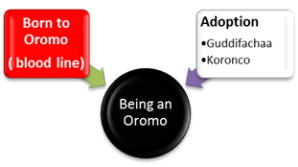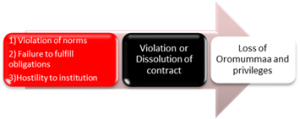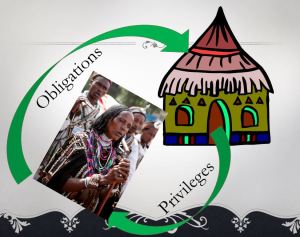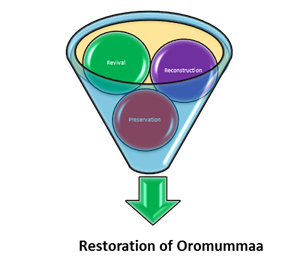The Addoyyee Institution
The Reciprocal Relationship between The Addoyyee Institution and Oromummaa
The Addoyyee institution is one of the Oromo institutions that are being revived to serve the emerging Oromo nation. In addition to serving its main constituents, young Oromo women, it also has immense potential to make positive contributions towards the development of Oromummaa. Utilizing this potential effectively, however, requires understanding the place and role of this institution in Oromo society. In my essay on this subject for Ogina, I will give a brief overview of the complex historical development of Oromumma (Oromo-ness) and conclude with an analysis of the importance of Addoyyeee for maintaining and cultivating Oromummaa.
Who is an Oromo?
 Who belongs to the Oromo, or how does one become Oromo? While such question is often complicated, the process of belonging and identity formation is quite developed among the Oromo. Hence, the general consensus is that there are two ways of becoming an Oromo.
Who belongs to the Oromo, or how does one become Oromo? While such question is often complicated, the process of belonging and identity formation is quite developed among the Oromo. Hence, the general consensus is that there are two ways of becoming an Oromo.
By being born to Oromo parents one automatically becomes a member of the Oromo nation. The second path is naturalization through adoption. The Oromo have two types of adoption. The first type is Guddifachaa (individual adoption), a process in which an individual is adopted by an Oromo person or family. The other is Koronco, when a group of people (family or clan) are adopted by an Oromo community. Both types lead to the incorporation of the individual and group into the Oromo nation, and granting of full citizenship with its privileges and obligations.
Oromummaa
The idea of Oromummaa has been discussed in rich detail by scholars such as Jalata, Kumsa, Megersa, and others, but a consensus on a concise definition of Oromummaa (Oromoness) is yet to be developed. A preliminary inquiry into the contextual usage of the term among the population leads us to believe that Oromummaa refers to a state of simultaneously being Oromo and belonging to the Oromo nation. That is, Oromummaa incorporates the identity of the person as a result of his/her membership to the community. Membership (belonging) to a particular community, in its classic sense, entails the member to fulfill a certain obligation to the community, which in turn provides privileges. Membership to a community, the process of extracting privileges and fulfilling obligation, therefore shapes the member’s identity.
A society relies on norms and institutions in order to enforce obligations and dispense privileges. Norms are the formal or informal rules that determine the values, beliefs, attitude, and behaviors that are developed to facilitate intra- and inter-group interactions and cooperation. Institutions are the structures and mechanisms which enable the society to enforce its norms. The Oromo nation is one of the societies that have a highly developed, multi-layered system, Gadaa, which enables it to enforce obligations and dispense privileges to its members. Within the Gadaa system, we find multiple institutions (Gumii Gaayyoo, Qaalluu, Siiqqee etc.) and norms (heera, seera, safuu, laguu & etc.).
A child born to the Oromo nation is born to privileges that would be provided to him/her by these institutions and norms. Through its institutions and norms, the society protects the infant against harm, respects her rights, and fulfills her needs. In addition to physically nurturing the baby, the society also instills the baby with its norms. This instillation process may be informal adaptation through exposure, observation and imitation, and formal training in skills, laws, history and myths of the nation. This process shapes the character, worldview, value, personality, and profession of the person. Therefore, the simultaneous process of nurturing and instilling (of norms) is meant to prepare the individual to properly enjoy her privileges and discharge the obligations.
 Upon a reaching certain age, enjoying the privileges become conditional upon fulfilling the obligations. These obligations can be classified into negative and positive. Negative obligations are conforming to the don’ts of the society; that is, refraining from violations of norms. Positive obligations refer to the practical contribution, such as defending the nation and its institutions, and tending to the collective welfare of the society. Failure to fulfill these obligations therefore constitutes violation of the contract between the member and the community resulting in loss of privileges or revocation of membership, depending on the severity of the violation.
Upon a reaching certain age, enjoying the privileges become conditional upon fulfilling the obligations. These obligations can be classified into negative and positive. Negative obligations are conforming to the don’ts of the society; that is, refraining from violations of norms. Positive obligations refer to the practical contribution, such as defending the nation and its institutions, and tending to the collective welfare of the society. Failure to fulfill these obligations therefore constitutes violation of the contract between the member and the community resulting in loss of privileges or revocation of membership, depending on the severity of the violation.
 Thus, growing up within the Oromo society, a person develops qualities and characteristics that make them a respectable, responsible and knowledgeable member of the society. Thus, such a person can be said to have acquired Oromummaa—she becomes a member of the Oromo nation in good standing. Oromummaa thus provides one with privileges and imposes obligations on her. Yet acquiring Oromummaa does not necessarily guarantee continuous flow of privileges. Failure to fulfill the positive and negative obligations could result in loss of privileges one gets due to his Oromummaa, and eventually loss of the Oromummaa Oromummaa itself.
Thus, growing up within the Oromo society, a person develops qualities and characteristics that make them a respectable, responsible and knowledgeable member of the society. Thus, such a person can be said to have acquired Oromummaa—she becomes a member of the Oromo nation in good standing. Oromummaa thus provides one with privileges and imposes obligations on her. Yet acquiring Oromummaa does not necessarily guarantee continuous flow of privileges. Failure to fulfill the positive and negative obligations could result in loss of privileges one gets due to his Oromummaa, and eventually loss of the Oromummaa Oromummaa itself.
The Abyssinian Conquest and its impact on Oromummaa
The process of acquiring and loosing Oromummaa that I have been discussing above presume proper functioning institutions. Following the conquest of the Oromo nation at the end of the 19th century the people and its institutions were exposed to danger. The institutions were attacked and destroyed, while the norms were suppressed and distorted. The alien rule and the assimilative policy of the state exacerbated the problem. Consequently, the Oromo institutions could no longer effectively enforce individual obligation, nor could they dispense privileges sufficiently. From then on, in order to benefit from the privileges, restoring the institutions and norms became a necessity. The restoration process includes three phases: preservation, reconstruction, and revival.
Preservation: 1900 onward
Following the conquest, an alien rule through alien institutions were imposed on the Oromo. Hence Oromo institutions lost the power they once had. The loss of self-rule therefore automatically led to loss of authority and power for the Oromo institutions. In order to further consolidate its control over the Oromo people and its resources, it had to uproot the Oromo institutions that could be a base of resistance. Thus, the destruction of Oromo institutions was intensified. The empire builders aimed to create a unified homogeneous country through assimilation of the various nations into the dominant culture. Since instilling new norms requires displacing the existing ones, the Oromo norms were ridiculed, chastised and even banned. Therefore, conquest and colonization brought an existential threat to the Oromo institutions and norms.
Faced with such threat to the individual and collective livelihood, lacking the means and ability to defend themselves, the most feasible option they had was to preserve as much of the institutions and norms as possible from further damage. Preservation implies the process of protecting and saving certain elements, if not all aspects of the institutions and norms. Since the collapse of the institutions and the alien rule had disabled cooperation and collective action at the national level, the task of preservation was largely a micro-level task, meaning it was undertaken at and the local level (by individuals, families, clans, localities etc.). Individuals might save utensils and tools, clans maintain certain traditional activities and localities continue to use some element of the institution. In this way, the Oromo were able to preserve significant amount of its norms and institutions against all odds. It seems that some localities were more successful in preserving a specific aspect of the institutions than others. For instance, it appears that the Tulama preserved the religion, the Arsi preserved family life (wedding), the Afran Qallo preserved Guma, and the Borana, Karayu, Gabra and Guji preserved the mega institution. Why certain localities chose or were able to preserve a specific element of the institutions is a question beyond the scope of this essay. Nevertheless, it’s clear that during the first half century of the conquest, preservation was the primary task undertaken by the Oromo. The fact that certain aspects of the institution and norms were preserved was a foundation and catalyst for the next stage – reconstruction.
Reconstruction
During the second quarter of the 20th century, it appears that various regions and communities had recovered from the trauma caused by the war of conquest that they began reconstructing their identity and institutions as a way of resisting further destruction and resisting the ever worsening economic exploitation. The generation of Oromos that came of age in post-conquest Oromo society found the elements of institutions that were preserved by their parents. The preserved norms and institutions must have sparked curiosity in the minds of those young people for the obvious reason that preserved institutions and norms preserved by their parents were different from what they were hearing and seeing in the outside world – what’s promoted by the state. Thus, some of them began investigating and studying the preserved elements. Having realized that what was preserved was incomplete, they began undertaking the work of reconstructing the institutions and norms by putting bits and pieces together. Yet before practical step towards reconstruction is taken, it was necessary to ascertain the volubility of the heritages and viability of the task — a process of awareness and consciousness. This can be considered stage one of the long term projects. The contribution of Sheik Bakri Sapalo stands out as a great example of this stage.
In the preservation of certain elements of the Oromo institutions and norms by his community, being one of the few individuals to have been educated allowed Bakri not only to recognize and appreciate his heritage, but also to realize what had been lost. He understood that further preservation and reconstruction can only be possible if and when his generation recognized and valued their heritage. Hence he used his oratorical and poetic abilities to call attention to the precious legacies, the danger they faced, and the need and possibility of protecting and reconstructing them. His use of Afaan Oromoo for his poetry served dual purpose towards the reconstruction project. One, by showing that Afaan Oromo can be used in such a “modern way”; it negated the campaign that painted the language as backward, outdated and useless. He used his poetry in his language to decry the injustice and destruction been committed by the alien system and agents. In doing so he directed his people’s attention to the destructive campaign, and also the possibility of further developing of the language.
Sheikh Bekri’s progressive move from utilizing the language for poetry to undertaking the hard work of inventing an alphabet for the writing of the language indicates that he had realized a) the destruction caused by the conquest was successful in part due to the fact that history, norms and institutions of the Oromo were not written b) although using the language would help to raise awareness, it being written is the best way of preserving and reconstructing it. Writing does not only help preserve and reconstruct the language, but also serves for preservation and reconstructions of other institutions and norms such as history, culture, etc. Considerable attention was paid and extensive efforts were made to development of Afaan Oromoo because Sheikh Bakri and his successors (Sheikh Mohammed Rashad, Haile Fida, etc.), acutely understood the importance of written language in preserving and reconstructing society’s institutions and norms.
Reconstruction Phase II
The local effort of reconstruction and preservation that have been undertaken at various regions put a spotlight on the institutions and norms that survived the conquest through preservation. This had a positive impact on raising the consciousness of the following generation and saving them from being lost by assimilating into the dominant culture. Basically the preservation and reconstruction of the Oromo institutions and norms allowed the new generation to see bits and pieces of the glorious heritage of their people. This era overlaps with intensification of the assimilation project with the help of modern education, having destroyed the institutions of the Oromo, and expropriated their land, the state foreclosed the possibility of upward mobility within the Oromo community for any aspiring youth. The only alternative for upward mobility was through assimilation into the dominant culture which required giving up ones identity. Yet as a number of Oromos moved up the ladder of power by subjecting themselves to the assimilation process, they began competing against the establishment, which responded by isolating and ridiculing Oromo elites. The threat and isolation put the Oromo on the path to self-rediscovery as a coping mechanism. As more and more of them became conscious about their situation, the Oromo elites began gathering in order to counterbalance their adversarial group—the establishment. It was such gatherings that lead to formation of Maccaa Tulama Association (MTA).
This initiative which aimed at advancing the collective interest of the Oromo elite was aided by the elements of Oromo institutions and norms that were preserved during the preceding eras. Seeing that their much ridiculed people once had and still maintain great institutions and norms provided them with tools for individual and collective self-esteem. Furthermore, if the coalescing Oromo elites were to effectively defend and expand their interest versus its adversary, their group needed institutions and norms that can coordinate collective action by dispensing privileges and enforcing regulations. Since effective coordination requires full functioning of the institutions and norms, speeding up the ongoing reconstruction was necessary. And the aim was to catalyze national collective action, at this stage; the reconstruction work had to be elevated to a macro level.
It was this realization that led the intellectual founders of the Maccaa Tulama to be preoccupied with writing history and reconstructing national symbols. Although they were supposedly forming a regional development organization, Haile Mariam Gemeda’s insistence for adopting the Odawa to be the emblem of the association — to name it after major clans instead of the administrative provinces — and Mammo Mazamir’s dedication to producing a written history of the Oromo, shows how well they grasped the importance of reconstruction. At that stage, putting a spotlight on the heritage that was preserved in all parts of the country was meant to help the various segments to find a common denominator. The objective of re-writing history was meant to be a catalyst for a national awakening and self-discovery. When this succeeds, it enables the re-imagination of the fragmented segments emerging as a unified nation. Consequently, because the crucial work of Hailemariam and Mammo was duly understood by their adversary, the two were singled out for speedy elimination. They were correctly identified as heads of the snake (MTA) where the dangerous venom was been produced and distributed.
Therefore, in the reconstruction process, the MTA played multiple roles. For one, its formation and adoption of the national symbols by itself signaled part of the re-instituting of the Oromo nation. Second, it also provided a venue and resource for individual and collective self-discovery. The association also served as a laboratory where bits and pieces of components were preserved by various segments and were brought together where experimentation was undertaken in order to restore the norms and institutions at the national level. Put another way, through the work of the association, the nation was reimagined, its foundation was reconstructed, and its identity as a unified polity reasserted. Although the MTA was banned within a few years, the work of reconstructing institutions and norms continued at an accelerated rate during the next several decades because it had already empowered numerous activists and generated grassroots energy. The further improvement of the writing system (adoption of qubee and development of the grammar by Haile Fida and Mohammed Rashad) and the mapping and naming of Oromia were undertaken with an impressive degree of success.
Revival: 1980’s onward
Once the institutions and norms that were preserved are supplemented by reconstruction, they have to be followed by revival — application. Revival therefore is a process of putting things back the way they were and making them function properly. Starting with individuals adopting Oromo names, organization of the armed forces in accordance with the historical Oromo structures followed by “officializing” Afaan Oromo, transforming Oromia from a map to real administrative structures, publication of Oromo history into text books, renaming of landscapes, expansion of Waaqeffanna, rebirth and popularization of Oromo holidays (Irreechaa, Muudaa) and so on were all forms of revival.
The three processes of restoration are a continuous and overlapping phenomena that whereby each stage requires and reinforces the other. For instance, preservation leads to and requires reconstruction in order to be effective. A generation that preserves heritage enables and gives incentive to the following generation to undertake reconstruction work of preserved institutions and norms. Yet unless reconstruction is undertaken, preservation will eventually fail because the institutions and norms will eventually wear out due to internal and external corrosive pressures. Reconstruction in the same fashion leads and requires revival. By putting bits and pieces together, reconstruction enables the functionality of the institutions and norms. Such implementation and activation of the institution is important for evaluating the success of the revival and reconstruction work, because such evaluation is necessary to identify the missing components and undertake further reconstruction. Thus, although one of these tasks might have attracted more attention at a given period, successful restoration requires continuously and simultaneously undertaking of all them. These tasks ought to continue even after a full restoration of Oromo institutions and norms because there is always a threat lingering in the name of modernization.
Oromummaa at present Stage
 The changes that have been taking place among the Oromo over the last century and the political developments in the last few decades have complicated the process of exit and entry to the Oromo.
The changes that have been taking place among the Oromo over the last century and the political developments in the last few decades have complicated the process of exit and entry to the Oromo.
As we discussed above, originally Oromummaa entails fulfilling obligations and enjoying privileges. The Oromo society was able to enforce the obligation and dispense privileges through its institutions and norms. However, the war of conquest, the resulting colonial system and its assimilation policy have significantly disabled the effective function of the institutions and norms of the society. Hence, in order to benefit from the privileges Oromummaa entails, the present day Oromo is obligated to preserve reconstruct and revive the Oromo institutions and norms. Put another way, in the present time, taking part in these three tasks is a requirement for acquiring Oromummaa.
Where does Addoyyee fit?
As mentioned in the introduction, a person born to the Oromo society enjoys privileges provided to them by the Oromo institutions. Addoyyee is one of the specialized institutions designed to protect, respect and nurture a young woman for her role in society. Addoyyee and Siiqqee are institutions through which a society dispenses privileges (protection, respect and fulfillment) to its female members. In a sense, since these institutions were used by female members of the society to coordinate their collective action, Addoyyee and Siiqqee could be considered as feminist institutions serving the interest of women. Addoyyee can be seen as a community within a community, whose primary purpose is to provide specialized service to young women to fulfill their psychological and emotional needs. By creating a space where teenagers of the same age socialize, it serves as a peer support network. Through mentorship from older women, the arrangement allows young women to acquire skills and develop wisdom and knowledge necessary for womanhood in the society. Therefore, the level of separation between the Addoyyee and Siiqqee institutions seems to have been designed with the purpose of allowing Addoyyee to have structural autonomy while benefiting from its functional relationship with its elder organization.
Addoyyee is one of the Oromo institutions that was preserved and have been undergoing reconstruction and revival in recent years. As such it contributes to and benefits from restoration of Oromummaa. Since Addoyyee is one of the major institutions of the Oromo, the revival and popularization of this institutions and gradual restoration of its norms by itself is a direct contribution to the larger project of restoring Oromummaa. Such restoration of one component of the larger institution energizes and motivates the society to seriously undertake the revival of the rest of the institutions. Similarly, the ongoing restoration of other institutions and norms (language, religion, history) also strengthens Addoyyee.
At present Addoyyee serves as a support network for young women in the Oromo community, contributing to their personal, social, and professional development .It is one of the fastest growing institutions that coordinates the resources of young women and contributes to the larger Oromo struggle and welfare of the community. Moreover, young Oromos girls who join Addoyyee not only form solidarity among themselves, they also adapt the values and norms of Oromummaa into their personal lives. By creating an opportunity where they can engage in collective action, Addoyyee is also an institution that develops future leaders for the Oromo society. Full restoration of the Addoyyee institution, like the rest of Oromo institutions, is an obligation for Oromos who wish to benefit from the privileges Oromummaa entails. If the Oromo people are to recover from personal and collective degradation, to fully overcome the internal fragmentation and escape poverty, we must fulfill obligation of restoring Oromummaa.
_______________________
Arfasse “Free Free” Oromiya is a graduate of the University of Minnesota and former president of the International Oromo Youth Association. She currently lives in New York City.
Source: http://ogina.org/issue6/issue6_arfasse_addoyyee_institution.html




Leave a comment
Comments 0